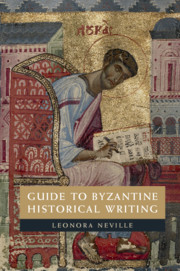Book contents
- Frontmatter
- Dedication
- Contents
- Acknowledgments
- Introduction
- Byzantine Historical Texts
- 1 Theophylakt Simokatta
- 2 Paschal Chronicle
- 3 George Synkellos
- 4 Chronicle of Theophanes
- 5 Patriarch Nikephoros
- 6 Scriptor Incertus de Leo V
- 7 Chronicle of 811
- 8 Megas Chronographos
- 9 George the Monk
- 10 Peter of Alexandria
- 11 Genesios
- 12 Theophanes Continuatus
- 13 Constantinian Excerpts
- 14 John Kaminiates
- 15 Symeon the Logothete
- 16 Leo the Deacon
- 17 Chronicle of Monemvasia
- 18 Chronicon Bruxellense
- 19 Psellos
- 20 John Xiphilinos
- 21 Michael Attaleiates
- 22 John Skylitzes and Scylitzes Continuatus
- 23 George Kedrenos
- 24 Nikephoros Bryennios
- 25 Anna Komnene
- 26 John Kinnamos
- 27 John Zonaras
- 28 Constantine Manasses
- 29 Michael Glykas
- 30 Eustathios of Thessaloniki
- 31 Joel
- 32 Niketas Choniates
- 33 George Akropolites
- 34 Theodore Skoutariotes
- 35 George Pachymeres
- 36 Nikephoros Gregoras
- 37 Ephraim
- 38 Constantine Akropolites the Grand Logothete
- 39 Chronicle of Morea
- 40 Nikephoros Kallistos Xanthopoulos
- 41 John VI Kantakouzenos
- 42 Michael Panaretos
- 43 Chronicle of Ioannina
- 44 Chronicle of Tocco
- 45 John Kananos
- 46 John Anagnostes
- 47 Leontios Machairas
- 48 Sylvester Syropoulos
- 49 Doukas
- 50 George Sphrantzes
- 51 Michael Kritovoulos
- 52 Laonikos Chalkokondyles
- Appendix A Time Periods Covered in the Histories
- Appendix B Timeline of Authors’ Lives
26 - John Kinnamos
from Byzantine Historical Texts
Published online by Cambridge University Press: 14 June 2018
- Frontmatter
- Dedication
- Contents
- Acknowledgments
- Introduction
- Byzantine Historical Texts
- 1 Theophylakt Simokatta
- 2 Paschal Chronicle
- 3 George Synkellos
- 4 Chronicle of Theophanes
- 5 Patriarch Nikephoros
- 6 Scriptor Incertus de Leo V
- 7 Chronicle of 811
- 8 Megas Chronographos
- 9 George the Monk
- 10 Peter of Alexandria
- 11 Genesios
- 12 Theophanes Continuatus
- 13 Constantinian Excerpts
- 14 John Kaminiates
- 15 Symeon the Logothete
- 16 Leo the Deacon
- 17 Chronicle of Monemvasia
- 18 Chronicon Bruxellense
- 19 Psellos
- 20 John Xiphilinos
- 21 Michael Attaleiates
- 22 John Skylitzes and Scylitzes Continuatus
- 23 George Kedrenos
- 24 Nikephoros Bryennios
- 25 Anna Komnene
- 26 John Kinnamos
- 27 John Zonaras
- 28 Constantine Manasses
- 29 Michael Glykas
- 30 Eustathios of Thessaloniki
- 31 Joel
- 32 Niketas Choniates
- 33 George Akropolites
- 34 Theodore Skoutariotes
- 35 George Pachymeres
- 36 Nikephoros Gregoras
- 37 Ephraim
- 38 Constantine Akropolites the Grand Logothete
- 39 Chronicle of Morea
- 40 Nikephoros Kallistos Xanthopoulos
- 41 John VI Kantakouzenos
- 42 Michael Panaretos
- 43 Chronicle of Ioannina
- 44 Chronicle of Tocco
- 45 John Kananos
- 46 John Anagnostes
- 47 Leontios Machairas
- 48 Sylvester Syropoulos
- 49 Doukas
- 50 George Sphrantzes
- 51 Michael Kritovoulos
- 52 Laonikos Chalkokondyles
- Appendix A Time Periods Covered in the Histories
- Appendix B Timeline of Authors’ Lives
Summary
The thirteenth- century manuscript Vaticanus Graecus 163 contains a history attributed to John Kinnamos covering the years 1118– 1176. The History covers the reigns of John II and Manuel I, and depicts both rulers favorably, especially Manuel. In the manuscript, the text is divided into two books. In modern editions, it is typically presented in four or seven books.
This text focuses on the lives of the emperors and their military affairs. It describes John II's war against the Hungarians and the Turks, and his death after a hunting accident. The History then follows the accession of John's favored younger son Manuel, Manuel's recapture of Antioch in 1144, plots against him, his conflicts with the Turks, the events of the Second Crusade, and Manuel's further military campaigns in both east and west, including in Egypt and Italy. With the exception of Louis VII, the text depicts the crusaders, and Latins in general, in a consistently unfavorable light. It also describes a theological dispute in the 1160s regarding the relationship between Father and Son in the Trinity.
Kinnamos does not provide precise dating for events, but seems to follow chronological order. His writing is less elaborate than that of some elite Byzantine rhetoricians of the twelfth century. Kinnamos's source base remains unclear. He may have drawn on his own experiences in the court and on campaign, as well as oral accounts, encomia, and possibly a variety of written documents.
The manuscript ends with events in 1176, four years before the end of Manuel's reign. It breaks offin mid- sentence, and Kinnamos may not have finished the work. Since the author frequently makes allusions to passages that never materialize, Carl Neumann argued that the surviving manuscript is an abridged version, whose copyist overleapt certain sections. Vasile Grecu and Charles Brand have made the case that the manuscript preserved the original version. Pointing to the sometimes unpolished prose and other textual features, they believe Kinnamos simply never revised his work, and may have left it unfinished.
- Type
- Chapter
- Information
- Guide to Byzantine Historical Writing , pp. 186 - 190Publisher: Cambridge University PressPrint publication year: 2018

